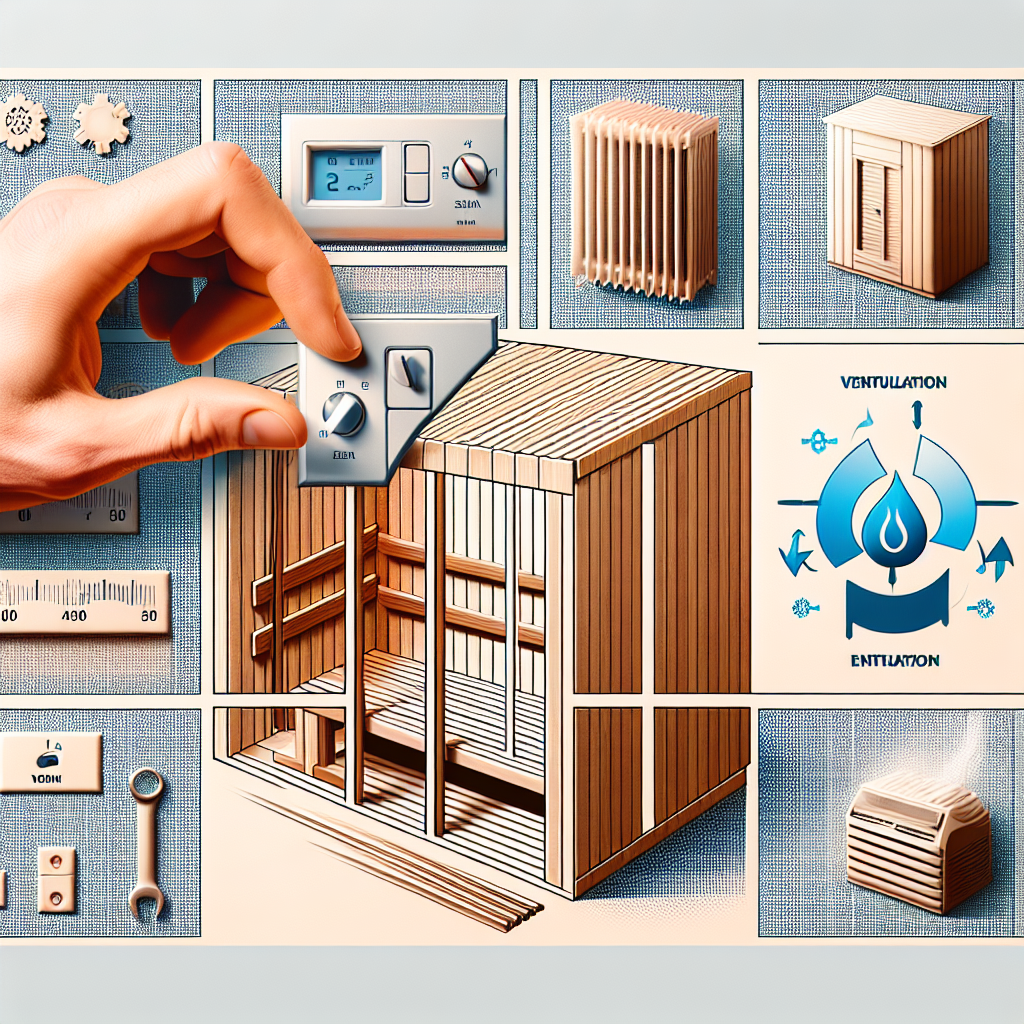Imagine entering a warm and serene sauna, enveloped in soothing heat that rejuvenates your body and mind. But what if the temperature is not quite to your liking? In this article, we will explore the various ways you can effortlessly adjust the temperature in a sauna to create the perfect oasis of relaxation tailor-made for your comfort. So, sit back, relax, and allow us to guide you on this delightful journey of temperature control in saunas.

Setting Up the Sauna
Setting up the sauna properly is essential to ensure that you can enjoy a comfortable and relaxing sauna experience. This includes choosing the right type of sauna for your needs, preparing the sauna before each use, and preheating it to the desired temperature.
Choosing the Sauna Type
When it comes to saunas, there are different types to choose from, including dry saunas, wet saunas, and infrared saunas. Each type has its own unique benefits and characteristics. Dry saunas, for example, use heated rocks to create a dry heat, while wet saunas produce steam by pouring water over these rocks. Infrared saunas, on the other hand, use infrared heaters to directly heat your body.
Consider your preferences and health requirements when selecting the type of sauna. Dry saunas may be more suitable for individuals who can tolerate high temperatures, while wet saunas are great for those who enjoy the sensation of steam. Infrared saunas provide a gentle heat that penetrates deeper into the skin, making them a popular choice for individuals with certain health conditions.
Preparing the Sauna
Before every sauna session, it’s important to prepare the sauna to ensure a clean and inviting environment. Start by removing any debris or dirt from the sauna benches and floor. Use a soft brush or broom to sweep away any dust or debris, and wipe down the surfaces with a mild cleaning solution. This will help maintain a hygienic and comfortable space for your sauna experience.
Additionally, ensure that the sauna is well-ventilated by opening any windows or vents. This will allow proper airflow and help prevent excessive humidity or stuffiness inside the sauna. Adequate ventilation is crucial for an enjoyable sauna session and will help regulate the temperature more effectively.
Preheating the Sauna
Once the sauna is prepared, it’s time to preheat it to the desired temperature. Begin by turning on the sauna heater or infrared heat source. Give it some time to warm up, typically around 30 minutes for a traditional sauna heater and less for an infrared sauna. This will allow the sauna to reach the optimal temperature for a comfortable and relaxing experience.
Controlling the Temperature
After setting up the sauna, it’s important to have control over the temperature to ensure that it is at a level that suits your preferences and comfort.
Using the Sauna Heater
If you’re using a traditional sauna, the sauna heater plays a crucial role in controlling the temperature. The heater will heat up the sauna rocks, which in turn radiate the heat into the sauna cabin. To adjust the temperature, simply adjust the sauna heater’s settings according to the instructions provided by the manufacturer. Typically, there will be a dial or buttons that allow you to increase or decrease the temperature.
Adjusting the Temperature Dial
Most saunas will have a temperature dial that allows you to easily adjust the heat level. This dial typically ranges from low to high, allowing you to set the sauna temperature to your desired level of warmth. Start at a lower temperature and gradually increase it until you find the perfect balance that suits your comfort level.
Monitoring the Thermometer
To ensure that the sauna remains at the desired temperature, it’s helpful to have a thermometer inside the sauna cabin. A sauna thermometer will provide you with accurate real-time temperature readings, allowing you to make any necessary adjustments to maintain the ideal heat level. Keep an eye on the thermometer during your sauna session to ensure that the temperature remains within your comfort range.
Optimizing Heat Distribution
To enhance the sauna experience and ensure even heat distribution, there are a few key factors to consider.
Using Sauna Stones
Sauna stones are placed on the sauna heater to help distribute heat evenly and create a more comfortable sauna environment. The stones absorb and retain heat, releasing it slowly into the sauna cabin. Make sure to use sauna stones specifically designed for saunas to ensure they can withstand the high temperatures. Proper placement of the stones on the sauna heater is crucial for optimal heat distribution.
Pouring Water on the Sauna Stones
To create steam and increase humidity in the sauna, it is common practice to pour water over the sauna stones. This will not only add moisture to the air but also increase the perceived temperature, making the sauna session more invigorating. Use a ladle or bucket to pour water over the stones, being careful to avoid direct contact with the hot stones to prevent scalding.
Positioning Yourself in the Sauna
Another important aspect of optimizing heat distribution is positioning yourself strategically inside the sauna. Heat rises, so the higher you sit in the sauna cabin, the hotter it will be. If you prefer a milder heat, sit on a lower bench, closer to the floor. Alternatively, if you enjoy a more intense heat, choose the higher benches. Experiment with different positions to find the sweet spot where you feel most comfortable.
Maintaining the Desired Temperature
Once you have achieved the desired temperature, it’s important to maintain it throughout your sauna session. Proper ventilation, controlling airflow, and replenishing the water supply regularly are key factors in maintaining a consistent and enjoyable sauna experience.
Ventilating the Sauna
Good ventilation is crucial to prevent excessive humidity and ensure a comfortable and safe sauna environment. Make sure the sauna has enough ventilation by opening windows or using an exhaust fan. This will allow fresh air circulation, help control the humidity level, and prevent the air from becoming stale.
Controlling Airflow
To maintain the temperature inside the sauna, you can control the airflow by adjusting any air vents that may be present. Opening the vents will allow more fresh air to enter, while closing them will help retain heat. Find a balance that suits your preference and adjust the vents accordingly to maintain the desired temperature.
Replenishing the Water Supply
As you enjoy your sauna session, the water you poured over the sauna stones will gradually evaporate, reducing the humidity and perceived heat. To maintain the desired level of warmth and humidity, it’s important to regularly replenish the water supply. Keep a container filled with water nearby and pour it over the sauna stones whenever needed to maintain optimal humidity and heat levels.

Safety Precautions
While saunas offer numerous health benefits, it’s important to take certain safety precautions to ensure a safe and enjoyable experience. Here are some key safety measures to keep in mind:
Avoiding Overheating
Be mindful of the temperature and listen to your body. If you start to feel lightheaded, dizzy, or excessively hot, it’s important to step out of the sauna and cool down. Overheating can be dangerous and can lead to heat exhaustion or heat stroke. Your safety and well-being should be your top priority, so always listen to your body and take breaks when needed.
Monitoring Your Time
Limit your sauna sessions to a reasonable duration. The recommended time can vary depending on factors such as your health condition, tolerance to heat, and the type of sauna being used. Start with shorter sessions of around 10-15 minutes and gradually increase the duration as you become more accustomed to the heat. Remember to take breaks in between sessions to allow your body to cool down and rehydrate.
Recognizing Signs of Discomfort
Pay attention to how your body feels during the sauna session. If you start to experience any discomfort, such as rapid heartbeat, difficulty breathing, or chest pain, exit the sauna immediately and seek medical attention if necessary. It’s important to be aware of your own limitations and prioritize your well-being above all else.
Additional Tips
To further enhance your sauna experience, consider these additional tips:
Using a Sauna Thermometer
Invest in a sauna thermometer to accurately monitor the temperature inside the sauna. This will help you maintain the desired level of heat and ensure a comfortable experience. Place the thermometer at a height where you normally sit or on a nearby wall for easy visibility.
Considering Sauna Accessories
There are various sauna accessories available that can enhance your comfort and relaxation. Consider adding a sauna pillow or cushion to make your sauna session more comfortable. Sauna hats or towels can also be used to protect your head from excessive heat and add a touch of luxury to your experience.
Consulting the Sauna Manufacturer
If you have any specific questions or concerns about adjusting the temperature in your sauna, it’s always a good idea to consult the sauna manufacturer. They can provide expert advice and guidance based on the specific model and type of sauna you have.
Remember, the sauna experience should be enjoyable and comfortable. By following these tips and taking the necessary safety precautions, you can create a perfect sauna environment that suits your preferences and allows you to reap the numerous benefits of this wonderful wellness practice.

